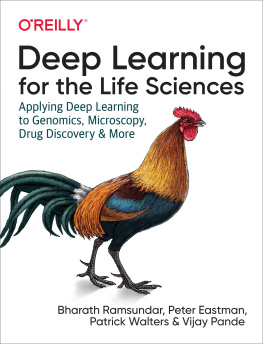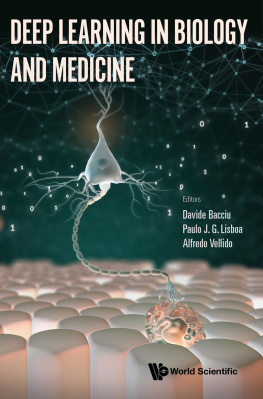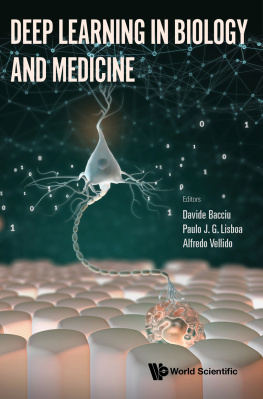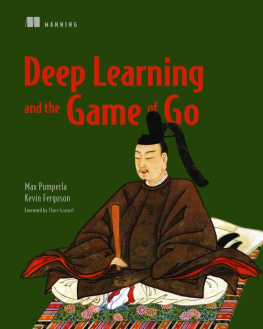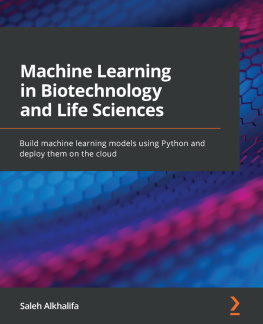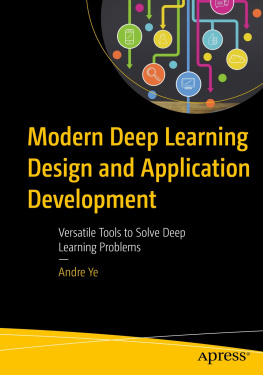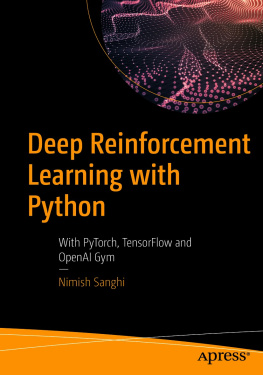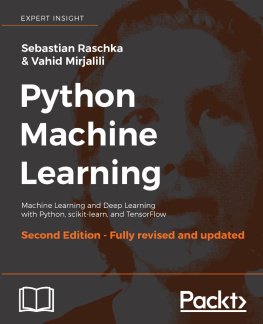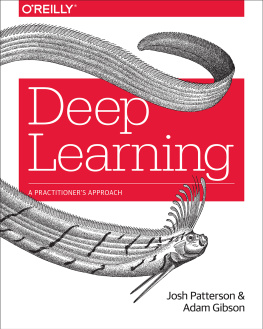Deep Learning for the Life Sciences
by Bharath Ramsundar , Peter Eastman , Patrick Walters , and Vijay Pande
Copyright 2019 Bharath Ramsundar, Peter Eastman, Patrick Walters, and Vijay Pande. All rights reserved.
Printed in the United States of America.
Published by OReilly Media, Inc. , 1005 Gravenstein Highway North, Sebastopol, CA 95472.
OReilly books may be purchased for educational, business, or sales promotional use. Online editions are also available for most titles (http://oreilly.com). For more information, contact our corporate/institutional sales department: 800-998-9938 or corporate@oreilly.com .
- Development Editor: Nicole Tache
- Acquisitions Editor: Mike Loukides
- Production Editor: Katherine Tozer
- Copyeditor: Rachel Head
- Proofreader: Zachary Corleissen
- Indexer: Ellen Troutman-Zaig
- Interior Designer: David Futato
- Cover Designer: Karen Montgomery
- Illustrator: Rebecca Demarest
- April 2019: First Edition
Revision History for the First Edition
- 2019-03-27: First Release
See http://bit.ly/deep-learning-life-science for release details.
The OReilly logo is a registered trademark of OReilly Media, Inc. Deep Learning for the Life Sciences, the cover image, and related trade dress are trademarks of OReilly Media, Inc.
The views expressed in this work are those of the authors, and do not represent the publishers views. While the publisher and the authors have used good faith efforts to ensure that the information and instructions contained in this work are accurate, the publisher and the authors disclaim all responsibility for errors or omissions, including without limitation responsibility for damages resulting from the use of or reliance on this work. Use of the information and instructions contained in this work is at your own risk. If any code samples or other technology this work contains or describes is subject to open source licenses or the intellectual property rights of others, it is your responsibility to ensure that your use thereof complies with such licenses and/or rights.
978-1-492-03983-9
[LSI]
Preface
In recent years, life science and data science have converged. Advances in robotics and automation have enabled chemists and biologists to generate enormous amounts of data. Scientists today are capable of generating more data in a day than their predecessors 20 years ago could have generated in an entire career. This ability to rapidly generate data has also created a number of new scientific challenges. We are no longer in an era where data can be processed by loading it into a spreadsheet and making a couple of graphs. In order to distill scientific knowledge from these datasets, we must be able to identify and extract nonobvious relationships.
One technique that has emerged over the last few years as a powerful tool for identifying patterns and relationships in data is deep learning, a class of algorithms that have revolutionized approaches to problems such as image analysis, language translation, and speech recognition. Deep learning algorithms excel at identifying and exploiting patterns in large datasets. For these reasons, deep learning has broad applications across life science disciplines. This book provides an overview of how deep learning has been applied in a number of areas including genetics, drug discovery, and medical diagnosis. Many of the examples we describe are accompanied by code examples that provide a practical introduction to the methods and give the reader a starting point for future research and exploration.
Conventions Used in This Book
The following typographical conventions are used in this book:
ItalicIndicates new terms, URLs, email addresses, filenames, and file extensions.
Constant widthUsed for program listings, as well as within paragraphs to refer to program elements such as variable or function names, databases, data types, environment variables, statements, and keywords.
Constant width boldShows commands or other text that should be typed literally by the user.
Constant width italicShows text that should be replaced with user-supplied values or by values determined by context.
Tip
This element signifies a tip or suggestion.
Note
This element signifies a general note.
Warning
This element indicates a warning or caution.
Using Code Examples
Supplemental material (code examples, exercises, etc.) is available for download at https://github.com/deepchem/DeepLearningLifeSciences.
This book is here to help you get your job done. In general, if example code is offered with this book, you may use it in your programs and documentation. You do not need to contact us for permission unless youre reproducing a significant portion of the code. For example, writing a program that uses several chunks of code from this book does not require permission. Selling or distributing a CD-ROM of examples from OReilly books does require permission. Answering a question by citing this book and quoting example code does not require permission. Incorporating a significant amount of example code from this book into your products documentation does require permission.
We appreciate, but do not require, attribution. An attribution usually includes the title, author, publisher, and ISBN. For example: Deep Learning for the Life Sciences by Bharath Ramsundar, Peter Eastman, Patrick Walters, and Vijay Pande (OReilly). Copyright 2019 Bharath Ramsundar, Karl Leswing, Peter Eastman, and Vijay Pande, 978-1-492-03983-9.
If you feel your use of code examples falls outside fair use or the permission given above, feel free to contact us at .
OReilly Online Learning
Note
For almost 40 years, OReilly has provided technology and business training, knowledge, and insight to help companies succeed.
Our unique network of experts and innovators share their knowledge and expertise through books, articles, conferences, and our online learning platform. OReillys online learning platform gives you on-demand access to live training courses, in-depth learning paths, interactive coding environments, and a vast collection of text and video from OReilly and 200+ other publishers. For more information, please visit http://oreilly.com.
How to Contact Us
Please address comments and questions concerning this book to the publisher:
- OReilly Media, Inc.
- 1005 Gravenstein Highway North
- Sebastopol, CA 95472
- 800-998-9938 (in the United States or Canada)
- 707-829-0515 (international or local)
- 707-829-0104 (fax)
We have a web page for this book, where we list errata, examples, and any additional information. You can access this page at http://bit.ly/deep-lrng-for-life-science.
To comment or ask technical questions about this book, send email to .
For more information about our books, courses, conferences, and news, see our website at http://www.oreilly.com.
Find us on Facebook: http://facebook.com/oreilly
Follow us on Twitter: http://twitter.com/oreillymedia
Watch us on YouTube: http://www.youtube.com/oreillymedia
Acknowledgments

